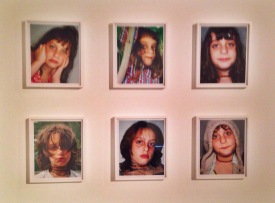Using the Glasgow Women’s Library’s 21 Revolutions series as a springboard, ‘Ripples on the Pond’ is an exhibition from Glasgow Museum’s collection, including painting, print, photography and film, exclusively by women. What I expected from this exhibition was a hard-core, perhaps even aggressive feminist atmosphere, but this was not the case. ‘Ripples on the Pond’ is a collection of innovative art works that happen to be by women, and the subtlety of the message that these women should be appreciated and admired as artists, in my opinion, more powerful than an angry protest about women’s rights.
My photograph of ‘Women in the City’ by Jacki Parry
Some of the works do convey feminist messages, for example, in ‘Women in the City’ by Jacki Parry, street names on a map of Glasgow are replaced by the names of women whose contributions to the city are acknowledged by the walking tours of Glasgow. This work is a clear challenge to the fact that street names tend to memoralise men, as opposed to women, exposing society’s tendency to remember men over women in history. Parry argues, through her art, that women, too, should be memorialised visually.

My photograph of ‘Girl Reading’ by Vanessa Bell
Another work with assertive feminist undertones is ‘Girl Reading’, a phonographic print by Vanessa Bell, who was a central member of the Bloomsbury group, along with her sister, Virginia Woolf. The print has a commercial feel to it, suggesting it promotes some kind of ideal, but there is a contrast between the soft blues and yellows of the room, and the dark outline of the girl and her book. Thus, the ‘ideal’ Bell creates is a domestic scene, in which a woman is not performing a domestic task, but rather an intellectual one, or simply enjoying herself. To me, this print conveys two messages, the first being that knowledge is power – the girl reading commands the image – and the second, an encouragement to defy gender stereotypes.

My photograph of ‘165 Stars, Found in GW Lending Library’ by Shauna McMullan
‘165 Stars, Found in GW Lending Library’, by Shauna McMullan comes from an interesting concept. It is made up of hand drawn asterisks in the margins of books donated to the library, presented in white on a blue backdrop. The work combines the stars of 165 different people, and the work is a combination of all of their small contributions. This has connotations of people, specifically women, working together, expressed through art, which might be interpreted as making a feminist assertion that women should work together. However, what I like about this work, more than any message that can be drawn from it, is the originality of the idea, and the unusual image created.

My photograph of ‘David Vetter’ by Corin Sworn
Other works in the collection are more personal, inspired by and connected to, the artists’ lives. A number of the works are personal reactions to current affairs and media portrayal of them, for example Corin Sworn’s ‘David Vetter’ drawings. David suffered from Severe Combined Immune Deficiency Syndrome, an ‘allergy to everything’, meaning he was isolated in a sterile environment until his death, aged 12. David was dubbed ‘The Boy in the Bubble’ by the media, and Sworn engages with this media fascination, creating a sense of isolation with the wide expanse around her drawings, and depicting the boy either coming out of a bubble.
My photographs of ‘This is me, this is you’ by Roni Horn
I particularly liked Roni Horn’s, ‘This is me, this is you’, which consists of a collection of pairs of photographs of her niece, taken in quick succession, forcing you to look more closely at images that, at first glance, seem to be identical pairs, adding another level of interest to what are already engaging snapshots.

My photograph of ‘Return to Nature (version two)’ by Jo Spence
Probably the most intimately personal is Jo Spence’s ‘Return to Nature (version two)’, which was part of a series called ‘The Final Project’, begun when she was diagnosed with leukaemia. As her illness prevented her from taking many photographs at this point in her life, in this series, she experimented with photographs she had already taken, combining pairs of photographs to create ‘post-reality’ superimpositions she called ‘photofantasy’. What I found really interesting about this was that she did not use computer technology, but instead projected pairs of transparencies and photographed them together, a technique I had never heard of before, and I really like the dream-like quality she creates with this unusual approach.
In all, I found this varied exhibition really interesting, in terms of the originality of the artwork, and the refreshing take on feminism that the exhibition as a whole produced.
Kirsty x
Ripples on the Pond is now showing in the Gallery of Modern Art



